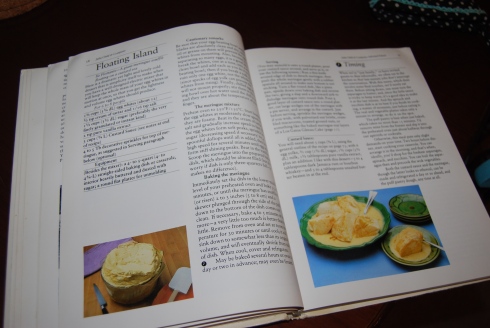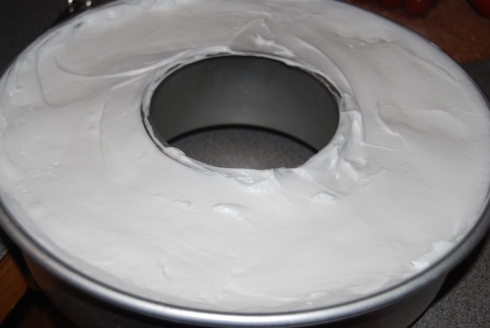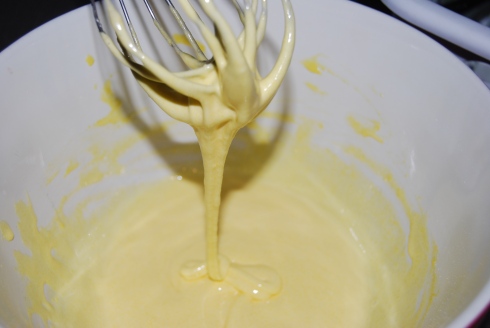Delicate. That’s the word to describe floating island — ill flottante in French — with its combination of meringue and creme anglaise. It makes sense to pair an egg white-based cake with an egg yolk-based custard. The two tastes and textures complement each other (it’s also an excellent example of kitchen pragmatism, a way to use both part of the egg).
Before Hannah suggested this dessert, I’d never heard of it, nor had I seen a recipe anywhere that I could remember. But I’ve wanted a second chance to get good at creme anglaise and I’ve never made a meringue quite like this.
A while back, our friend Nicole gave me a copy of “Julia Child and Company,” a volume filled with menus for entertaining. Of course, ill flottante made an appearance as the finale for an “informal dinner,” and I used her recipe as reference for the technique (photo below). I particularly like Julia’s image of ill flottante as “a giant meringue souffle floating on a custard sea.”
Hannah had suggested a few recipes to work from, and I ended up using a combination to suit my parameters. Because of the size of my pan (not a traditional bundt pan but a jelly roll pan), I wanted a meringue recipe that didn’t use too many egg whites, and I didn’t want to overdo it on the amount of creme anglaise. Embarrassingly, I ran out of regular granulated sugar, so I skipped the caramel sauce (though I do think it would have tied the dessert together).
For the meringue, I used Martha Stewart’s tutorial, which I found immensely helpful. For the creme anglaise, I used Barefoot Contessa’s recipe, which makes a modest amount of sauce and doesn’t require heavy cream, only regular milk (which I think works just fine).
Note: While searching for recipes and Julia Child inspiration, I stumbled across this modern update of her floating island, an adaptation with apricot creme anglaise and almond meringue. This would be a nice holiday dessert.
Regardless of the recipe, the meringue starts out the same: beating the egg whites into a froth, watching for soft peaks, adding the sugar gradually and waiting for stiff peaks to magically appear (with cream of tartar and salt helping this process along). Because I ran out of granulated sugar, I attempted to substitute powdered sugar, which ended up working OK. But had I read further in my research, I would have discovered that more powdered sugar would have helped the meringue keep its shape after baking (something involving sugar crystallization during baking, and the lower density of the powdered sugar; I admit I am no food scientist).
The meringue looked quite nice before baking, and it didn’t look half bad after, but there were some textural and structural issues. You can see that it cracked down the middle, which is not at all how Martha or Julia’s turned out. Still, a fine first try, seeing as I’ve only ever made the cookie meringues or spread meringue on a pie.
While I waited for the meringue to cool, I started on the creme anglaise. Credit goes to Andrew, who beat the egg yolks with the sugar (again powdered) until, as Julia says, the “mixture is pale yellow and forms the ribbon,” which I think is a wonderful way of describing the exact consistency we’re looking for. No mixer required here, just a whisk and a little time (and of some corn starch, which makes it thicken properly later on).
Next, the part that I’ve failed at oh so many times, which requires a lot of patience: the tempering of the eggs with the scalded milk. This time, I made extra sure to dribble in just enough milk to the egg and sugar so it adjusted to the heat without scrambling. And it worked!
The whole egg and milk mixture then was whisked together over medium heat until the froth and the bubbles dissolved, leaving me with a creamy, pale yellow sauce. And immediately, off the heat it went. This probably took all of 20 minutes from the ribboning to the thickening.
Back to matters of structural integrity. My “meringue souffle” fell a little too much after taking it out of the oven, and even though I checked to make sure it didn’t stick to a skewer poked in the middle, it was a bit runny. So I put it back in the oven for about 5 minutes (perhaps a great mistake), which seemed to help a little. But in the picture you can see it looks a little slimy once I turned it out, and it did release a lot of liquid after it had fully cooled.
The best parts of the meringue were the caramelized spots on the edges; these were chewy and rich. I agree with Hannah that the meringue was a bit slimy inside, and strangely spongy in places. It tasted a lot like angel food cake, of which I’ve never been particularly fond of, but this had just the right flavor for me. Perhaps my problem with angel food cake is that I don’t like the cake part (the texture) but that I like the taste of the egg whites. Because this is essentially a simplified version of angel food cake, I liked it quite a bit.









